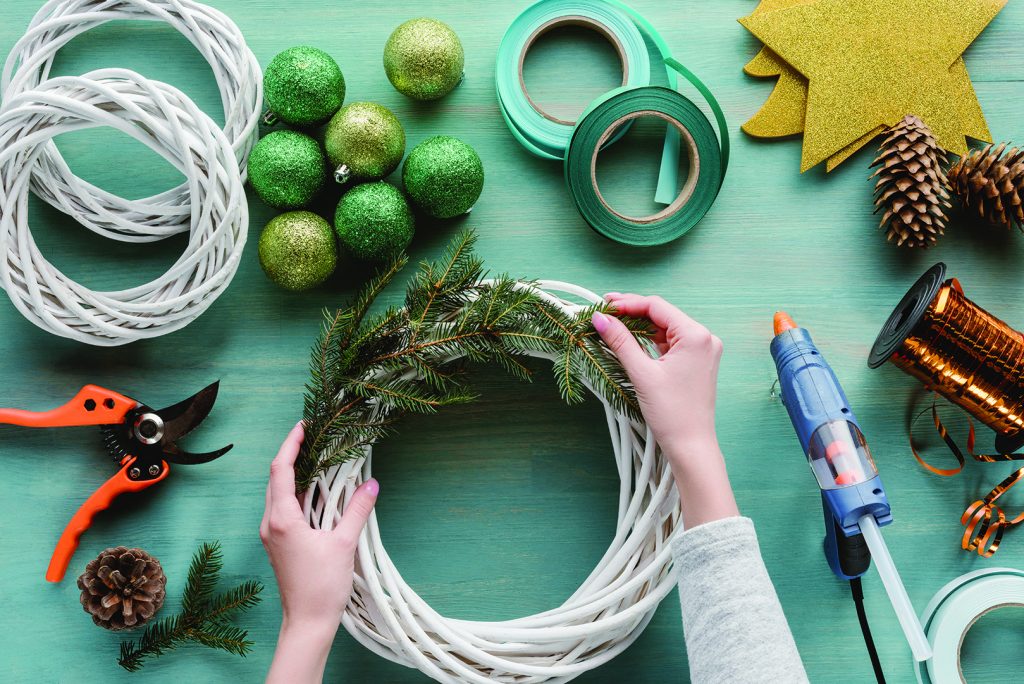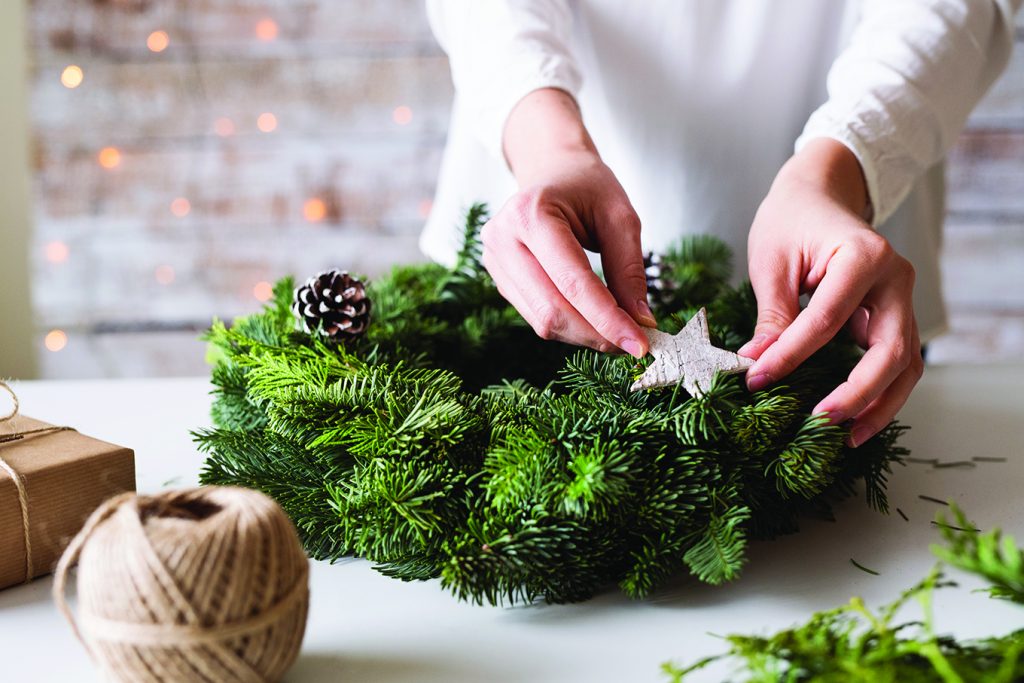Welcoming Wreaths
09 Dec 2020
Nothing rings in winter quite like wreaths, so try these tips to create gleeful garlands for your home
By Carol Brock
Wreaths are joyful and welcoming reminders of the holiday season. They’re pretty, bright and a cheery sight on drab winter days. Premade wreaths are always festive, of course, but a homemade wreath is a creative project that’s fun for the whole family, says Jessica Beard, wreath maker and “woman of many hats” at Lafayette Florist Gift Shop & Garden Center in Lafayette. “Wreaths add a bunch of color to a space and really brighten it up,” says Beard, who can’t resist “a really pretty bow.” “Wreaths look really cute on front doors, above mantels, and they’re just fun.” Fortunately, making them doesn’t require any special skills—“except maybe a bit of patience,” Beard says. Here are her tips for making wow wreaths.
1. Collect your tools.
You’ll need wire and/or twine; wire cutters, pruning shears or scissors; a hot glue gun and/or floral adhesives, “depending on how heavy whatever you’re putting into the wreath is,” Beard says. Branches, for example, require wiring into a form while faux botanicals are easier to glue into a form. Light gloves are recommended when handling prickly greenery and cones.

2. Choose a form to attach materials to.
There are two common ones: a heavy wire single- or multiple-ring form, and a circular dried-grapevine form. Both come in different sizes, depending on your needs. “Grapevine wreaths work pretty well as a base,” Beard says, “especially for silks like flowers and artificial foliage, because you can just feed them through the grapevine branches.”
 3. Choose your materials.
3. Choose your materials.
“That’s the fun part!” Beard says. There are endless possibilities. Artificial botanicals, berries, dried flowers, pine cones, moss, pods, dried mushrooms, evergreen branches, ornaments, shatterproof balls, baubles, faux birds and other wildlife, dried fruit, ribbon and cinnamon sticks are just a few choices. Cut garden flowers are another option: “Strawflowers, statice flowers and pampas grasses are cool additions, and they dry pretty well,” Beard says. Tools, forms and materials can be found at craft stores like Michaels, online, at floral shops and in your own yard.
4. Wing it, or plan ahead?
Beard likes to have a plan. She first groups materials into different sections, “like branches and evergreens in one section, berries in another section, pine cones in another and flowers in another.” Then she’ll attach each individual section in various increments around her form. “So, if you’re doing evergreens and berries, I’d do all my branches and evergreens first, then add in all the berries, and then the pine cones, to get the base done,” she explains. “Then I’d add in all my focal flowers and lastly any other additions.” She prefers to work in a circle with all her materials, “going in one direction to give the wreath an even flow.” However, she adds, “Winging it is perfectly fine, too!”

 5. Faux or real wreaths?
5. Faux or real wreaths?
“It doesn’t really matter if you use faux or natural materials, no matter what level you’re at as a wreath maker,” Beard says. Natural materials, like evergreens, junipers and pine cones, add nice scents to the home, but the wreath will only last for the season. “You can use anti-transpirant spray, like Wilt Pruf, and mist it often with water to help it retain its scent and last longer.” Faux wreaths last forever, she says—“just fluff them up when you take them out of storage.”
6. What’s a good wreath for beginners to make?
Beard suggests buying a wreath with minimal adornment, like greenery and berries, and then adding items “to make it your own.” She recommends fluffing premade wreaths first. “Pull apart the branches and fluff them to give the wreath a fuller feel—not a smashed-in-the-box feel.”

7. Rules of thumb for making wreaths.
“My first rule is to measure twice, cut once. You can always cut a stem shorter, but if you cut it too short to begin with, you can’t make it grow back. So make sure it’s the length you want it before you cut it,” Beard says.
 Her second rule is to cut evergreens into lengths of 4 to 6 inches each, and then bundle them. “So, if you have a couple sprigs of spruce, pine or juniper, gather them at about the same height, cut them and then wire the stems’ bases together. Then wire one bundle onto your wreath form, and layer another bundle onto the form and continue doing this around the circle in one direction.”
Her second rule is to cut evergreens into lengths of 4 to 6 inches each, and then bundle them. “So, if you have a couple sprigs of spruce, pine or juniper, gather them at about the same height, cut them and then wire the stems’ bases together. Then wire one bundle onto your wreath form, and layer another bundle onto the form and continue doing this around the circle in one direction.”
Her third rule: Make it 3D. “You don’t want a flat wreath. Layer your materials so you have some coming out from the sides and more coming toward you.”
What if you need wreaths in a pinch?
Beard says to drop by Lafayette Florist. “We have botanical wreaths year-round and lots of holiday wreaths during the season.”












